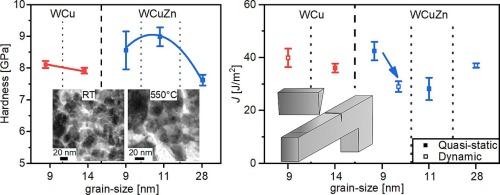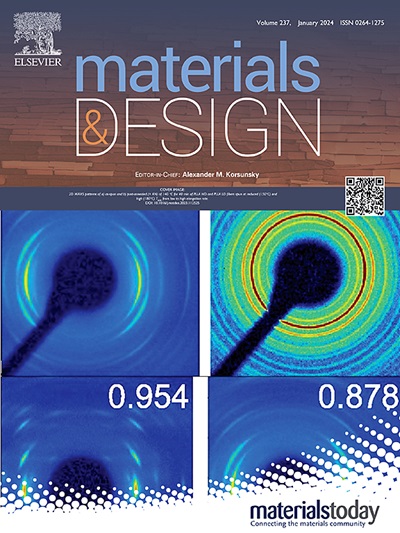评估钨基纳米复合材料的断裂韧性:微机械方法
IF 7.9
2区 材料科学
Q1 MATERIALS SCIENCE, MULTIDISCIPLINARY
引用次数: 0
摘要
纳米结晶钨铜复合材料能很好地结合两种元素的优异材料特性。这项工作研究的钨铜复合材料是由钨含量为 80 wt.%、铜含量为 20 wt.%、锌含量为 20 wt.%的元素粉末或 α-黄铜制成的。此外,还利用高压扭转来压实粉末,通过晶粒细化来强化所产生的复合材料,并通过在 RT、400°C 和 550°C 之间改变变形温度来定制纳米晶体系中的晶粒大小,从而分别获得 9 nm、14 nm 和 28 nm 的晶粒大小。硬度测量结果表明,当晶粒大小低于 11 纳米时,硬度行为从正态过渡到反霍尔-佩奇态。为了检查断裂特性,制作了横截面为 10x10 µm2 的微型悬臂弯曲梁。对这些实验的评估表明,其断裂韧性为 3 MPam。在晶粒尺寸为 9 纳米到 14 纳米之间,断裂韧性略有下降,这表明晶界内聚强度有所降低。晶粒大小增加到 28 纳米时,断裂韧性的趋势发生了逆转,上升到 3.4 MPam,这表明激活了其他变形机制,如位错累积和孪生。此外,锌合金提高了复合材料的强度,并保持了复合材料的断裂韧性,有利于提高耐损伤性。本文章由计算机程序翻译,如有差异,请以英文原文为准。

Assessing the fracture toughness in Tungsten-based nanocomposites: A micro-mechanical approach
Nanocrystalline tungsten-copper composites can favorably combine the outstanding material properties of both elements. This work investigates tungsten-copper composites fabricated from elemental powders with 80 wt.% tungsten and either copper or -brass containing 20 wt.% zinc, respectively. Moreover, high-pressure torsion is used to compact the powders, strengthen the resulting composite by grain refinement, and tailor the grain-size in the nanocrystalline regime by varying the deformation temperature between RT, 400°C and 550°C, resulting in grain-sizes of 9 nm 14 nm and 28 nm, respectively. Hardness measurements revealed a transition from normal to inverse Hall-Petch behavior for grain-sizes below 11 nm. To examine the fracture properties, micro-cantilever bending beams with a cross-section of 10x10 µm2 were fabricated. Evaluation of these experiments indicated a fracture toughness of 3 MPa. The slight decrease of fracture toughness between a grain-size of 9 nm to 14 nm indicates a reduction of the grain boundary cohesion strength. The grain-size increase to 28 nm reversed the trend in fracture toughness and raised it to 3.4 MPa, which points to activating additional deformation mechanisms, such as dislocation-accumulation and twinning. Additionally, alloying with zinc raised the composites strength and retained the composites fracture toughness, benefiting the damage tolerance.
求助全文
通过发布文献求助,成功后即可免费获取论文全文。
去求助
来源期刊

Materials & Design
Engineering-Mechanical Engineering
CiteScore
14.30
自引率
7.10%
发文量
1028
审稿时长
85 days
期刊介绍:
Materials and Design is a multi-disciplinary journal that publishes original research reports, review articles, and express communications. The journal focuses on studying the structure and properties of inorganic and organic materials, advancements in synthesis, processing, characterization, and testing, the design of materials and engineering systems, and their applications in technology. It aims to bring together various aspects of materials science, engineering, physics, and chemistry.
The journal explores themes ranging from materials to design and aims to reveal the connections between natural and artificial materials, as well as experiment and modeling. Manuscripts submitted to Materials and Design should contain elements of discovery and surprise, as they often contribute new insights into the architecture and function of matter.
 求助内容:
求助内容: 应助结果提醒方式:
应助结果提醒方式:


